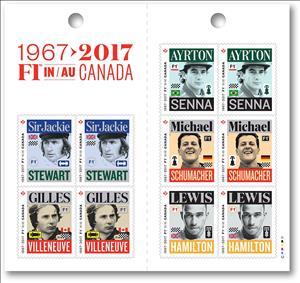Booklet Pane: 50th anniv. of Formula 1 in Canada, booklet pane (Canada 2017)
50th anniv. of Formula 1 in Canada, booklet pane (Canada 2017)
16 May (Canada ) within release 50th anniversary of Formula 1 in Canada goes into circulation Booklet Pane 50th anniv. of Formula 1 in Canada, booklet pane face value 10*P No Face Value
| Booklet Pane 50th anniv. of Formula 1 in Canada, booklet pane in catalogues | |
|---|---|
| Stanley Gibbons: | Sg: CA 3275a |
Booklet Pane is square format.
Booklet pane of 10, 2 each #2993-2997) (BK669). Perforation Serpentine Die Cut 16.6.Also in the issue 50th anniversary of Formula 1 in Canada:
- Souvenir Sheet - 50th anniversary of Formula 1 racing in Canada mini sheet face value 5*P;
- Stamp - Lewis Hamilton face value P;
- Stamp - Lewis Hamilton face value P;
- Stamp - Sir Jackie Stewart face value P;
- Stamp - Ayrton Senna face value P;
- Stamp - Ayrton Senna face value P;
- Stamp - Michael Schumacher face value P;
- Booklet - 50th anniversary of Formula 1 racing in Canada booklet face value 10*P;
- Stamp - Gilles Villeneuve face value P;
- Stamp - Gilles Villeneuve face value P;
- Stamp - Michael Schumacher face value P;
- Stamp - Sir Jackie Stewart face value P;
- Stamp - Ayrton Senna face value P;
- Stamp - Gilles Villeneuve face value P;
- Stamp - Lewis Hamilton face value P;
- Stamp - Michael Schumacher face value P;
- Stamp - Sir Jackie Stewart face value P;
- Booklet Pane - 50th anniv. of Formula 1 in Canada, booklet pane face value 10*P;
Booklet Pane 50th anniv. of Formula 1 in Canada, booklet pane it reflects the thematic directions:
A car is a wheeled, self-powered motor vehicle used for transportation and a product of the automotive industry. Most definitions of the term specify that cars are designed to run primarily on roads, to have seating for one to eight people, to typically have four wheels with tyres, and to be constructed principally for the transport of people rather than goods. The year 1886 is regarded as the birth year of the modern car. In that year, German inventor Karl Benz built the Benz Patent-Motorwagen. Cars did not become widely available until the early 20th century. One of the first cars that was accessible to the masses was the 1908 Model T, an American car manufactured by the Ford Motor Company. Cars were rapidly adopted in the United States of America, where they replaced animal-drawn carriages and carts, but took much longer to be accepted in Western Europe and other parts of the world.
Famous People refers to the fame and public attention accorded by the mass media to individuals or groups or, occasionally, animals, but is usually applied to the persons or groups of people (celebrity couples, families, etc.) themselves who receive such a status of fame and attention. Celebrity status is often associated with wealth (commonly referred to as fame and fortune), while fame often provides opportunities to make money.
Formula One, commonly known as Formula 1 or F1, is the highest class of international racing for open-wheel single-seater formula racing cars sanctioned by the Fédération Internationale de l'Automobile (FIA). The FIA Formula One World Championship has been one of the world's premier forms of racing since its inaugural running in 1950. The word formula in the name refers to the set of rules all participants' cars must follow. A Formula One season consists of a series of races, known as Grands Prix. Grands Prix take place in multiple countries and continents on either purpose-built circuits or closed roads.
Sport is a form of physical activity or game. Often competitive and organized, sports use, maintain, or improve physical ability and skills. They also provide enjoyment to participants and, in some cases, entertainment to spectators. Many sports exist, with different participant numbers, some are done by a single person with others being done by hundreds. Most sports take place either in teams or competing as individuals. Some sports allow a "tie" or "draw", in which there is no single winner; others provide tie-breaking methods to ensure one winner. A number of contests may be arranged in a tournament format, producing a champion. Many sports leagues make an annual champion by arranging games in a regular sports season, followed in some cases by playoffs.
A stadium (pl.: stadiums or stadia) is a place or venue for (mostly) outdoor sports, concerts, or other events and consists of a field or stage completely or partially surrounded by a tiered structure designed to allow spectators to stand or sit and view the event.
A vehicle (from Latin: vehiculum) is a mobile machine that transports people or cargo. Typical vehicles include wagons, bicycles, motor vehicles (motorcycles, trucks, buses), railed vehicles (trains, trams), watercraft (ships, boats), aircraft and spacecraft. Land vehicles are classified broadly by what is used to apply steering and drive forces against the ground: wheeled, tracked, railed or skied. ISO 3833-1977 is the standard, also internationally used in legislation, for road vehicles types, terms and definitions.






